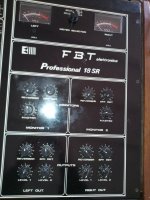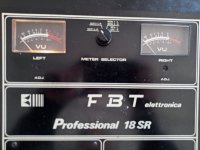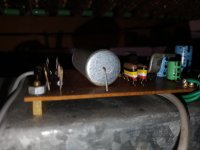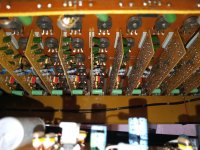Bad ceramic caps came in batches. Lots of sleazebag salesmen were out there in the nineteen seventies offering bargains to purchasing agents. Even free dinners or gratuities sometimes. Incoming inspection of some companies spotted the problems, others not. Broken case or metal showing through case are bad signs for ceramic caps. Ceramic caps are cheap in the .01 uf & .1 uf 50 v varieties these days. Check your power supplies to see if they are shorted. If so, that is a likely suspect. Changing a lot of those would be tedious but may be necessary to salvage all those standard sized (maybe) slide pots. Even some stereo pots. I changed one worn out slide pot on a $35 used mixer, the master volume pot, for a Bournes pot, and already on the 3rd use it is dropping out.I took a peak within the chassis and I noticed that many ceramic caps have big cracks on them (not that circuit issues can be detected with a naked eye)
If you test a few and the pots don't have contact with the wiper, other than master volume, ditch it. 50 or so slide pots are $$$ and the new one I bought was ****. The rotary pots on the 197? Ampeg I bought were fine after 50 years. One reason you see that brand logo on stages all the time behind famous bands on TeeVee.
Last edited:
Where are you located? It’s easier to show than tell when it gets complicated like this. Too many variables to get through. Maybe someone near you can help.
That stinks of a very poorly made cable. either at input, output, or both.THOUGH when I fiddle around with the TS cable that goes into the FBT's output it starts humming and suddenly it becomes ground "ground sensitive" (pass my stupid term) , when I touch the guitar strings OR the FBT's chassis the humming gets much louder .. no guitar output though..
FIRST is to check both, by using them straight between Guitar and VOX amplifier.
Both must work fine, no hum or anything, even if you grab plugs and try to move them around, twist cables, etc. , Guitar cables are designed to be abused.
Then you try them at FBT input, trying to get VU meters indicate something, try all combinations of pot positions, input switches, etc.
Post 3 or 4 pictures of you actual mixer: a full front panel one, then a couple closeups as needed to be able to read labels, then the back panel.
Your input and output jacks are suspect, internal leaf contacts and switches weaken and make poor or no contact. corrosion kills contact, etc.
For now do not remove parts one by one for testing outside, even less ICs, that´s a common noob mistake which adds new damage to the original one end ends in half dismembered equipment thrown in the corner garbage dumpster.
Obviously the first thing I've done was test the cables, even on the VOX , and they work perfectly , I would never de-solder any ICs , why would I? I haven't even spotted the issue yet , and I don't even have an oscilloscope! All I could do is test the voltages and check for DC , I will post some pictures soon guysThat stinks of a very poorly made cable. either at input, output, or both.
FIRST is to check both, by using them straight between Guitar and VOX amplifier.
Both must work fine, no hum or anything, even if you grab plugs and try to move them around, twist cables, etc. , Guitar cables are designed to be abused.
Then you try them at FBT input, trying to get VU meters indicate something, try all combinations of pot positions, input switches, etc.
Post 3 or 4 pictures of you actual mixer: a full front panel one, then a couple closeups as needed to be able to read labels, then the back panel.
Your input and output jacks are suspect, internal leaf contacts and switches weaken and make poor or no contact. corrosion kills contact, etc.
For now do not remove parts one by one for testing outside, even less ICs, that´s a common noob mistake which adds new damage to the original one end ends in half dismembered equipment thrown in the corner garbage dumpster.
Yessir! Just can't seem to get a clean signal through though , the light on the VU Meter (right) is dead (gotta check the fuses as soon as I put that chassis on a proper bench , still , here's some crappy pictures I took yesterday when took I peak inside , I'll eventually post decent ones toodoes this mixer show any sign of life when powered up?
Attachments
I took these yesterday , I know they're bad pics , but I was in a rush , check out the ceramic caps on the reverb tank , those cracks , 80% of this mixer's caps have cracks in them , didn't see any bulges on the electrolytic ones .. though that doesn't mean anythingPictures of the bad caps please? Some like to see the wreckage.
Also it may help us provide repair tips.
https://en.wikipedia.org/wiki/Electrolytic_capacitor
Attachments
well now that your in there the first thing to do would be to check supply voltages.
and without a better pic it appears that all the pots and buss wiring are handled by one large pc board and if there's problem on the foil side it would need to be completely dissembled, what a PITA...
at this point i wouldn't worry about the cracked caps figuring out where and why it isn't passing signal would come first replacement of all those is not a guaranty of making it operational and those cracks may not be a problem. if you get it functional you can then decide if it's feasible cost wise to replace them.
and without a better pic it appears that all the pots and buss wiring are handled by one large pc board and if there's problem on the foil side it would need to be completely dissembled, what a PITA...
at this point i wouldn't worry about the cracked caps figuring out where and why it isn't passing signal would come first replacement of all those is not a guaranty of making it operational and those cracks may not be a problem. if you get it functional you can then decide if it's feasible cost wise to replace them.
hmm i was looking at the pics in the first post and now i'm curious as to whether or not the multicore on the back labeled "remote input" is in fact paralleled to those channel inputs? or could it be that without the snake/ stagebox there no input and the 1/4's are in fact inserts?
Those potentiometers appear to be easily accessible to the meter probe. I'd check the wipers on all of them for resistance to one end before spending any time on this. You check from middle terminal to one end. Of course make resistance check with the power off.
Master volume pot plus maybe one channel pot bad: okay normal wear. Replacing one or two that were adjusted frequently is part of upgrading a used mixer. Many pots lost contact with the wiper, this is a piece of garbage. I've never seen any of this brand on stage with known bands on the television. Plus any corroded input or output switching jack as Mr. Fahey pointed out. Although simple oxidation of a 1/4 phone jack switch can be handled by abrasion with a contact file (not sandpaper).
Master volume pot plus maybe one channel pot bad: okay normal wear. Replacing one or two that were adjusted frequently is part of upgrading a used mixer. Many pots lost contact with the wiper, this is a piece of garbage. I've never seen any of this brand on stage with known bands on the television. Plus any corroded input or output switching jack as Mr. Fahey pointed out. Although simple oxidation of a 1/4 phone jack switch can be handled by abrasion with a contact file (not sandpaper).
Last edited:
I am fairly sure the remote input connector is meant for a snake. Now for the simple task of finding the connector/snake component. 🙂hmm i was looking at the pics in the first post and now i'm curious as to whether or not the multicore on the back labeled "remote input" is in fact paralleled to those channel inputs? or could it be that without the snake/ stagebox there no input and the 1/4's are in fact inserts?
Yes, always the first step. And with what looks like two power transformers, it may have multiple power supplies with many outputs.well now that your in there the first thing to do would be to check supply voltages.
- Home
- Source & Line
- Analogue Source
- Help with *RARE* Vintage Mixer



